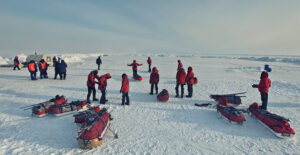In 1900, during the last of the glory days of arctic exploration, Baron Eduard von Toll led a little-known expedition to the Russian far north. A classic exploration tale, it is cloaked in both mystery and tragedy.
Eduard von Toll (born 1858) was a renowned geologist and zoologist who in 1885-6, took part in a scientific expedition to the New Siberian Islands. Here, he believed that he spotted a distant, unknown land that he concluded was Sannikov Land. This mysterious and ultimately illusory island was first spotted by Yakov Sannikov in 1811. Intrigued, the Russian Admiralty dispatched ships to find it in 1820, but thick sea ice thwarted every attempt to reach its supposed location, and no one even claimed to have seen the land. Until Toll.
Illusory islands
Sannikov Land was one of those will o’ the wisps not uncommon in the sketchily mapped Arctic of that era. Robert Peary claimed to have seen Crocker Land over the Arctic Ocean. Not to be outdone by his rival, Frederick Cook declared a Bradley Land in a similar location. Both of these latter men were hoaxers trying to ingratiate themselves with sponsors and to drum up funding for a future expedition. But Toll’s illusion seems to have been genuine.

Eduard von Toll.
Toll spent years trying to persuade people to sponsor his quest, and in 1900, the Imperial Academy of Sciences in Russia finally agreed. The Russian expedition was to explore and study the Taymyr Peninsula and the New Siberian Islands. As head of the expedition geological research, Toll would also have the chance to pursue his Sannikov Land.
Toll and 19 other men set out for the Arctic in June of that year. From the start, the journey was difficult. Their ship, the Zarya, leaked significantly, a second ship that was supposed to deliver coal to them had to turn back, there was not enough room for all the food they required, and two crew members were discharged for bad behavior. There was also a power struggle between the captain and Toll, and the constant threat of encroaching ice.
A man obsessed
Toll and his team managed to map uncharted rivers and islands, collect fauna and flora, and analyze glaciers, but Sannikov Land remained tantalizingly elusive. They pushed further and further north. Multiple small groups set out with dog sleds to do research and hunt for Sannikov Land. After 19 months, they had made no progress and were ordered to bring the expedition to a close. Toll had just one final summer to find his island.

The west coast of the Taymyr Peninsula, showing Zarya’s wintering site and the areas explored by Toll’s expedition. Map: ARCTIC Vol. 34, No. 3, 1980
In June 1902, Toll and three crew members took three dogsleds and two double kayaks north to Bennett Island, to create a base from which they could search for Sannikov Land. As they left, Toll handed a letter to the captain. The envelope read: “To be opened in the event that the expedition loses its ship and has to retreat to the mainland without me, or in the event of my death.”
In the letter itself, he added, “In case the ship cannot reach Bennett Island, I shall try to return to the New Siberian Islands before the severe winter cold, and then by the winter route to the mainland.”
Trapped in the ice
While Toll searched for Sannikov, the rest of the crew carried out a number of small scientific forays. By August 8, the Zarya was trapped in the ice and drifted rapidly southwest. After a week, the winds changed and the ice slackened, and Captain Matisen began fighting his way back north.
On August 17, the Zarya had made it to the entrance of Neprich’ya Bay, much to the delight of the two men who had been left there tending the sled dogs. On August 21, Matisen set out for Bennett Island with only 60 tonnes of coal left. Ultimately, impassable ice, shallow water, and fog barred every route to the island.
By September 5, there were only 9 tonnes of coal left, and the sealed instructions from Toll stated that he would wait for them until September 3. Reluctantly, Matisen headed south.
Before returning to St Petersburg, Matisen carried out the contingency plan drafted by Toll, leaving warm clothes, fuel, and food at one designated depot in the hope that Toll and his team would collect them on their way to the mainland.
In February 1903, a crew member named Brusnev led a party of seven with five sleds and 65 dogs toward New Siberia. In April, Kolchak set out for Bennett Island with 140 dogs, 17 men, multiple sleds, and a whaleboat. The rescue missions for Toll were underway.

The Zayra in its winter berth. Photo: ARCTIC, Vol. 34, No. 3
Kolchak and his men reached the island on August 17 and walked to the point where Toll had arranged to leave any messages. There were three notes. The first confirmed Toll’s arrival on the island on August 3, 1902. The second was a map of the island with the location of a hut they had built. The third noted a change in the location of the hut.
They found the hut with relative ease, but it was half-filled with snow and ice. In a box by the hut, they found a fourth letter. This one was addressed to the president of the Academy of Sciences and dated November 1902. It told them that in July, they had had to kill all their dogs for meat, so further travel would be by kayak. They also reported on their exploration of the island and confirmed that they were setting off on their return journey south with supplies for 14 to 20 days. There was no mention of Sannikov Land.
No clues
Kolchak searched the hut for more clues to no avail, then traveled south in search of Toll. With Brusnev’s team, they followed various difficult routes until December but found no trace of Eduard von Toll.
What makes this more mysterious is that Toll, an experienced explorer, started their southward journey at a particularly treacherous point. Kolchak reasoned that it must have been a lack of food that drove them to do this because they had enough fuel to last the winter on Bennett Island.
In one message, von Toll mentioned that they had killed a number of reindeer, so it has been speculated that they believed so strongly that the Zarya would return for them or that they would be able to find food on the island, that they didn’t ration any of their supplies for winter. But with little information and no trace of any of the men, we will likely never know what happened to them.






